The 2010 Toyota RAV4 Takes on the Top Seven SUVs of 2010
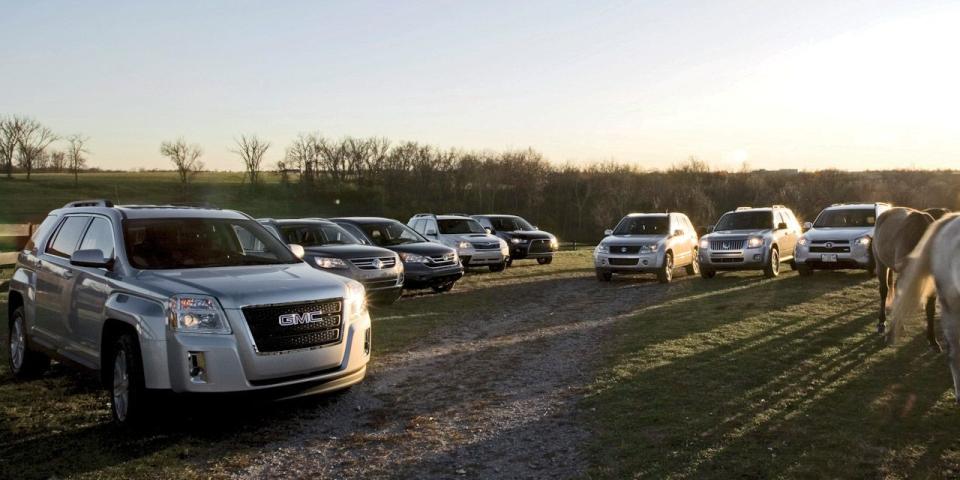


Last time we wrung out the automotive galaxy of miniature SUVs [“Mud Puppies,” February 2008], we, uh, really had to wring them out. That’s because we sank a couple of them and doused the rest in liquid clay, prompting outrage from off-road clubs, a few manufacturers, and the state of Michigan.
We resolved this time to avoid the primordial goo in favor of the genteel plantations and quarter-horse farms of Bluegrass Country, which offered the bonus of genuine BBQ joints. At one such eatery, in fact, the waitress eventually approached our table and made this startling announcement: “We are now officially out of ribs.” Upon returning to the hotel that night, assistant tech editor K.C. Colwell complained, “Oh, man, I think I’ve got the meat sweats.”
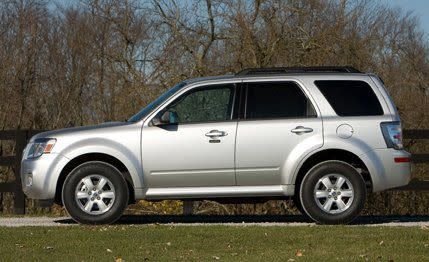
In truth, one doesn’t associate raging carnivorism with these docile vehicles, which Americans still view as SUVs but we regard as tall wagons. Why not a Camry wagon instead of a RAV4 or an Accord wagon instead of a CR-V? Whenever we’ve proffered that argument, however, we’ve been met with blank stares. So here we go again with the “mild horses,” strong on practicality but mostly less fun than that pony your parents rented for your sixth birthday.
This time around, we’ve deleted the Jeep Liberty and the Nissan Rogue, which didn’t win previously and are unchanged. We included no Hyundai because an all-new Tucson is looming but not yet available. And GM’s envoy on this outing was the new GMC Terrain. To that mix we added a couple of turbocharged newcomers: VW’s Tiguan and Subaru’s recently updated Forester.
We opted for automatic transmissions, the highest-output engine, and all-wheel drive. Alas, we could locate only front-drive versions of the Terrain and the Tiguan. Sorry.
Given the insurance claims following our most recent mini-SUV test, we went to great pains this time to assure a damage-free outing. Did you know that horses enjoy eating side-view mirrors, windshield wipers, $12,000 Nikon cameras, and paint right down to bare metal? Neither did we.
The optional V-6 in the Ford Escape and Mercury Mariner is now rated at 240 horsepower—a 40-horse increase—and the deservedly maligned four-speed automatic has been binned in favor of a modern six-speed. Also new are rearview mirrors with convex magnifiers in the outer corners, aimed at the driver’s blind spots—quite useful as we reversed the Mariner through a herd of unruly ponies.
This SUV finished last mostly because of its flaccid suspension. It scored the slowest lane-change speed and the second-worst skidpad grip—in fairness, both maneuvers were handicapped by overaggressive stability control—then went on to log the worst braking distance by quite a margin. The 16-inch tires may be complicit in this, as may be the Mariner’s tallest-in-group status. The moment we reached the hills of West Virginia, the Mariner lived up to its seagoing moniker by rolling, tossing, and pitching—a pale-blue Dearborn trawler in a gale.
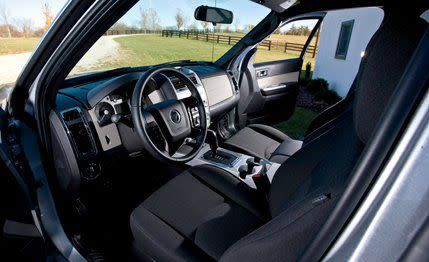
The other knock against the Mercury was that, at wide-open throttle, it made the most racket, and the quality of the racket was judged the most abrasive. On the upside, as one voter put it, “While the Honda struggles up grades with kickdowns and revs aplenty, the Mercury just chugs easily over hill and dale.” We do wish the shifter’s menu offered more than just “D” and “L,” however.
Other pluses: The Mariner offers a simple center stack, great visibility—in part because of its razor-thin A-pillars—and a bargain-basement price. In this group, in fact, it carried an as-tested sticker $1728 less than any other’s. It also proved a poised, serene, stable interstate cruiser, with a plush ride and comfortable seats upholstered in grippy, classy-looking fabric. When we asked our voters which SUV they’d pick if they had to drive to L.A. tomorrow, two pointed fingers at the Mariner. “Of course, when I got there,” added one, “I’d rent something that actually offered some fun.
Just as the Mariner’s V-6 enjoyed a colossal bump in power, so has the Suzuki’s, rising from an anemic 185 horses to a that’s-more-like-it 230. Unfortunately, the Grand Vitara remains porky, which might explain why it logged the second-slowest sprint to 60 mph, the second-worst quarter-mile ET, and—ahem—the worst observed fuel economy.
The Grand Vitara now comes with a standard nav system, which also is removable, meaning you can deploy it on hikes to previously undiscovered discount-liquor stores. The interior is otherwise somber and somewhat dated, enlivened only by a dark marble-look veneer that somehow recalls the Formica in the lobby of a ’60s-era Vegas hotel.
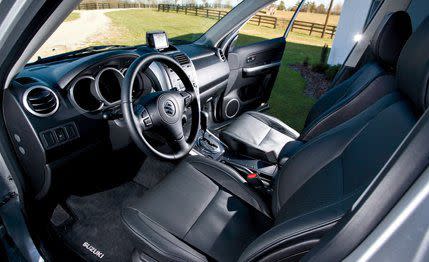
All eight of our crack voters agreed that the Suzuki was the most trucklike of the assembled mini-utes, and it’s probably no lie, given the integrated ladder frame in its unibody. The truckishness extends to an unyielding ride and actual off-road prowess, as demonstrated during our sodden 2008 soirée. In addition to short overhangs, our tester’s center diff could be locked in both four-wheel-drive high as well as low. Add to that hill-descent control, hill-hold control, and 7.9 inches of ground clearance, and you’ve got a feisty little mudder that can also be flat-towed by switching the transfer case into neutral.
Unfortunately, the Suzuki’s bad-boy persona wears thin after a couple of hours. The steering is a tad heavy at low speeds, turn-in could be sharper, and the tall shifter requires Schwarzeneggian effort as it clunks through a maze of strangely arrayed detents.
Given all of this implied brutishness, you’d suppose the Grand Vitara is cavernous within. Nope. In fact, it is tied with the VW for least front interior volume, finished last for rear interior volume, and tied again with the little VW for least cubic feet of storage behind the rear seat.
“Unless you’re off-roading,” offered Colwell, “I don’t see any interesting driving dynamics here.” Maybe the Suzuki is aimed at ego-shaky males who can’t abide a cute-ute grocery getter.
GMC’s Terrain is the sister ship to the Chevy Equinox and, apart from styling, the two don’t differ much. Which means we get to pick at a familiar scab. The Terrain is the longest SUV in this group and rides on a wheelbase that extends 7.4 inches beyond any competitor’s, making it a Clydesdale among Shetland ponies. What should be a “mini” SUV weighs 4008 pounds—more than a quarter-ton heavier than, say, the Subaru Forester. And that’s without all-wheel drive. Even attached to a 264-horse V-6 (a $1500 option), the Terrain consistently felt as if it wanted to saunter back to the barn and strap on the oat bag.
On West Virginia’s narrow farm roads, the Terrain rarely felt fully connected to the tarmac and heaved about as if it might suddenly spill into the oncoming lane. That sapped driver confidence, which is a shame because the Terrain’s skidpad grip—tied with the taut little CR-V’s—proves it can cling with the best of them.
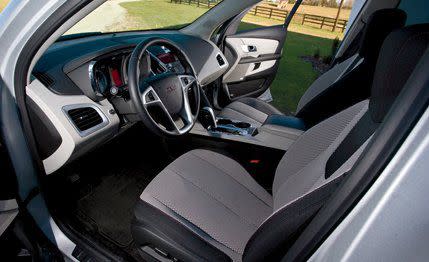
Several editors complained about the front seats, noting a short seat cushion that was oddly dished, encouraging slouching. This SUV also lost votes for its steering, which was light but lifeless on-center, requiring a major twirl to initiate any change in direction. Moreover, GM has formatted the six-speed automatic not for fun but for fuel economy. Unless your foot is more or less jamming the accelerator pedal clean through the fire wall, the transmission just relentlessly upshifts. The manumatic helps a little, but it’s a strange, inch-long, thumb-actuated rocker on the side of the shift lever, sufficiently fiddly that you’ll not often use it.
Not all is lost, however. The Terrain tracked like a champ. Its V-6 was quietest at idle. Its platform was solid and rattle-free. And, from 70 mph, it stopped in the shortest distance, a considerable feat given its mass.
Study the details—the cockpit’s futuristic “floating” center stack and the contrasting red stitching, for instance—and you’ll see that the new General Motors is now quite serious about small SUVs. But as one editor put it, “What we have here is a ‘professional grade’ Equinox—competent but not playful.”
Freshened for 2010, the Outlander GT’s V-6 produces 10 more horses, fed via an outsized version of the Lancer Evo’s grille, now evidently capable of sucking in leaves, roadkill, and possibly a stop sign or two. Ignore the steep base price; the Outlander comes equipped with so many standard amenities that it might require a three-page Monroney sticker.
This SUV essentially shares its platform with the Lancer sedan, and Mitsubishi’s strategy was to make this a sporting proposition. On the skidpad, at least, the plan worked, with the Outlander logging best-in-class grip. In backwoods Bluegrass Country, however, it wasn’t as engaging. Its heavy steering tended to load up abruptly even when the front tires hadn’t. And there was a little too much body roll upon turn-in, causing this vehicle’s considerable heft to shift to the outer front wheel.
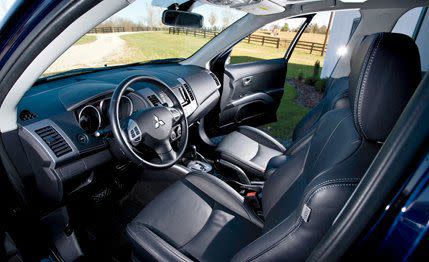
Moreover, the secondary controls were difficult to learn. Fit and finish was mediocre, with gaps on the dash that varied wildly. And above 75 mph, the Mitsu whipped up a maelstrom of wind noise and tire thrum.
On the other hand, we loved the paddle shifters, which were big, easy to reach, and summoned gears with lightning speed. And between the front seats resides the “Super-All Wheel Control” knob that commands the center diff to apportion power front to back and side to side in three modes: “tarmac,” “snow,” and “lock.” Curiously, the lock mode is operable at all speeds.
We must also credit Mitsubishi for being amusing. First, the lower quarter of the Outlander’s liftgate folds downward, creating a tailgate capable of accommodating 440 pounds of picnic. Second, a third-row seat is available. Well, “seat” isn’t the right word. It’s more like three pieces of rebar rattling inside a roll of felt, with flip-up headrests fashioned from Ping-Pong paddles. Wrote associate website editor Jared Gall, “No child is going to be comfortable back there unless he’s unconscious.”
In the end, the Outlander is like a politician trying to be all things to all people. The message gets muddled.
New for 2009, the Forester—the vehicle most likely to be parked in the lot of a Whole Foods store—is all growed up. It’s 2.9 inches longer and 1.8 inches wider, and it benefits from an extra 3.6 inches of wheelbase. Moreover, the less intrusive rear suspension allows the distance between the aft wheel wells to swell by 5.2 inches. In this group, the Subaru can thus carry the largest piece of plywood.
What the driver notices first about this soft-roader is its bright, open, airy cockpit. You sit bolt upright, amid vast expanses of unused headroom, and the huge windshield and backlight are a boon to sightlines. It’s a pleasant place to conduct business.
Subaru’s turbocharged and intercooled flat-four by no means produces the most power in this group, yet the Forester was the quickest to 30 mph and the second-quickest to 60 mph, in part because it weighed the least. Turbo lag is minimal, but you soon learn not to light-off that secondary oomph in the middle of a 90-degree turn, where it can upset the chassis and passengers alike. Another turbo side effect: Premium fuel is mandatory. Idle quality could be better, and, after long interstate slogs, the boxer can begin to drone.
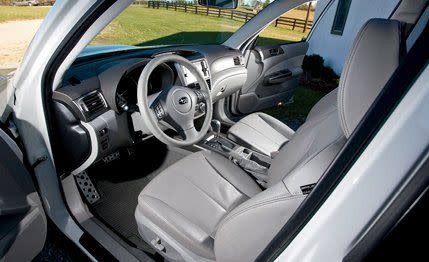
This is the second 2.5XT we’ve tested that evinced crash-through sufficient to set various cockpit bits and subassemblies in motion. The ride isn’t harsh, but those distant ticks, rattles, and groans do not a good first impression make. And on the subject of rigidity, our man Gall noted, “You can even feel quick steering corrections ripple back through the structure.”
With the 2009 redesign, the five-speed manual is no longer available with the turbo, so your only option is a four-speed automatic, which seems unconscionable at this price. Yet there were no transmission diatribes in the Subie’s logbook. In fact, the manumatic proved quick and precise, and, as one voter put it, “In the hills, you can just leave it in third all day.”
Overall, this is a gratifying blend of agility, practicality, and performance. It’s interesting to note that before we calculated observed fuel economy, the Forester was in third place. Turbos can be thirsty.
In our 2008 “Mud Puppies” comparo, the CR-V finished second to the RAV4, although it was a statistical dead heat: 208 points to the Honda’s 206. Back then, the CR-V’s 2.4-liter inline-four—the only powerplant available then and now—produced only 166 horsepower. In the interim, Honda has located an extra 14 horses—mostly via a bump in compression—but that still leaves the CR-V 20 behind the next-weakest SUV here. The Honda was thus the slowest to 60 mph and was 1.8 seconds astern the RAV4 through the quarter-mile.
Even as its engine was huffing and puffing near its 7100-rpm redline, the CR-V nonetheless had little trouble pacing our group through the hills. For that, we can thank its taut chassis—unfazed by even the wildest back-holler whoop-de-dos—and its linear, communicative steering, which tells you all you need to know about road textures and grip. The CR-V can be placed confidently anywhere mid-turn, and nothing upsets it; witness its winning lane-change velocity.
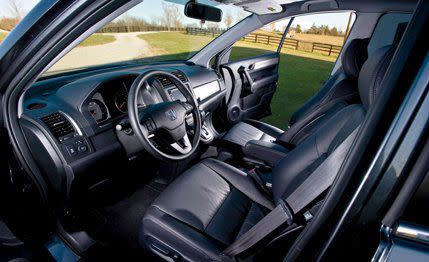
We always think of the CR-V as an itty-bitty thing, but it approaches cavernous inside. It tied the RAV4 for greatest rear-seat comfort, in fact, and managed a three-way tie for the most cubic feet behind the rear seat.
Honda has freshened the 2010 CR-V with a zillion small upgrades—folding armrests that are an inch wider, for example—but the car otherwise feels the same, notably in the richness of its interior surfaces and their tasteful detailing. When you have the bestselling SUV in America, you fear making big changes.
We’d nonetheless suggest one: optional turbochargers or a V-6. If Toyota can do it for as little as $28,610, Honda can, too. A V-6 may help boost towing capacity—as it is, the existing CR-V can pull only a wimpy 1500 pounds. More important, this four-banger, dare we say it, is feeling a little wheezy. At idle, it proved lumpy and noisy, with an abrupt clunk every time the A/C compressor kicked on and off.
Mini-ute buyers claim to worship at the altar of fuel economy. Yeah? Then contemplate this: Over 1050 miles of Joie Chitwood–style driving, the RAV4 V-6 delivered an observed 24 mpg. The CR-V? The same.
You don’t expect much personality in the cute-ute niche, but VW’s Tiguan is a raucous little delinquent, sort of like Mike Tyson at a sorority slumber party. Our voters alternately called it “the Tiggie,” “the Tigster,” “the Tiglet,” and, in one case, “Fred,” although that was the work of contributing editor Fred M.H. Gregory.
Here’s what the Tiguan is: a GTI on stilts. No surprise, then, that it earned best-handling status, backed up by the surest brake feel and perfectly weighted, accurate steering. Part of its goat-like nimbleness can be attributed to its diminutive dimensions. The Volkswagen is the shortest overall in this herd, riding on the least wheelbase. Sort of a rolling square. Keep in mind, however, that if this had been a 4MOTION model (starting at $27,050), some of that agility would have gone missing.
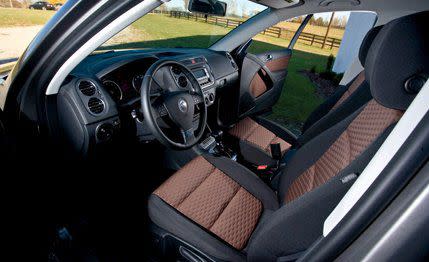
The dimensions, alas, intrude upon the gorgeous cockpit, which was voted the classiest of the bunch. The Tiguan’s back seat was cramped for three riders, aggravated by space-wasting plastic bins at either end of the cushion and a center console that crowded the hump rider’s knees. Consider this a four-passenger machine. What’s more, the Tig can carry the fewest cases of beer and the shortest length of pipe.
This VW might have given the Toyota a stronger run for its money but for a pair of faults. First, its turbocharged inline-four is strangely noisy—the Tiguan was loudest at a 70-mph cruise and at idle. Second, in straightforward “D” mode, the automatic transmission proved dimwitted—agonizingly slow to kick down, agonizingly quick to grab fifth or sixth. The cure was to leave it permanently in sport mode, which responds smartly when it sees rapid throttle inputs. Or you can bang away at the Tiptronic in its separate shift gate. But, hey, why not give us a DSG?
“I like this thing,” said editor-in-chief Eddie Alterman, “but it always makes me ask, ‘Wouldn’t a five-door GTI or a Jetta SportWagen be more satisfying when we’re talking front-drivers?’ ”
In 2008, a four-cylinder RAV4 defeated all of its closest competitors. Twenty-four months later, a six-cylinder RAV4 repeats the feat. By day two of our four-day drive, no one knew which vehicles would finish in second through eighth places. Yet everyone knew where the Toyota would finish.
Despite its size, what the RAV4 does best is drive like a car, and nearly like a sports sedan, in fact. Its platform is shared with no other vehicle, so it’s not too surprising that every component feels custom-built and perfectly integrated, as if the engineers who designed the drivetrain talked to the engineers who tuned the chassis who talked to the engineers who dialed in the steering who talked to the engineers who calibrated the brakes.
Fitted with the most-powerful-in-class V-6, the RAV4 is the quickest to 60 mph, is the fleetest through the quarter-mile, and offers the greatest top speed. Yet it is also the smoothest of the bunch and—this is the incredible part—managed to tie the Honda’s little four-banger for best observed fuel economy despite having two more cylinders.
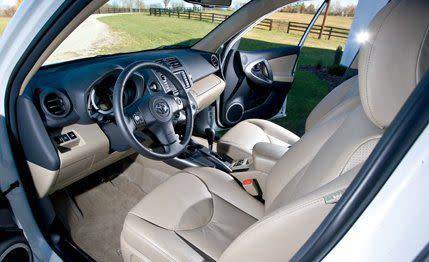
And the kudos for this compact SUV didn’t stop there. The Toyota’s transmission was deemed the slickest, never drawing attention to itself. The chassis imposes disciplined body motions on the vehicle while simultaneously delivering a ride as plush as the Mariner’s. The RAV4 tied the CR-V for greatest rear-seat comfort. At idle, the V-6 proved so velvety that several of us tried to start an already running vehicle. And if you’re in the habit of carrying multiple cases of beer—who isn’t?—the Toyota’s cargo bay will swallow the most.
Complaints were few. The headliner is cheesy, and the plastic-clad A-pillars need to be covered in fabric. The black cargo tonneau cover is fiddly and appears to have been made from a Glad garbage bag. And the base of the shifter travels through a flimsy plastic sliding panel, when a traditional boot would have been friction-free and easier on the eyes.`
Otherwise, this Toyota is good-looking, reliable, well-built, and enjoyable—what most of us seek in a spouse. At the Tokyo motor show, Akio Toyoda said of his company’s cars, “We’ve got to make them fun.” He won’t have to work too hard on this one.
('You Might Also Like',)

 Yahoo Autos
Yahoo Autos 